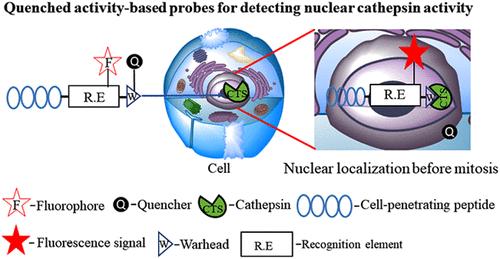基于核取向猝灭活性的新型探针将组织蛋白核定位与有丝分裂联系起来
IF 9.1
1区 化学
Q1 CHEMISTRY, ANALYTICAL
引用次数: 0
摘要
半胱氨酸组织蛋白酶是在癌症和其他疾病中高度上调的重要蛋白酶。虽然他们报道的位置主要是内溶酶体,一些证据表明他们的核定位和参与细胞周期。我们的目标是生成工具来研究组织蛋白酶在细胞周期进程中的参与。为了研究细胞核组织蛋白酶的活性,我们设计了细胞核定向猝灭活性探针(qABPs),通过连接细胞穿透肽(CPPs)。qABPs是一种活性位点导向化合物,通过探针和酶活性位点之间的共价连接,可以直接实时监测酶的活性。对CPP-qABPs进行生化评价,结果显示探针具有强效性和选择性;细胞分离、多模态流式细胞术成像和延时电影显示了活细胞中的核组织蛋白酶活性。有趣的是,这些探针揭示了一个时空模式,核组织蛋白酶在有丝分裂前激增,这表明组织蛋白酶在细胞分裂中的作用尚未被揭示。总之,这些核导向qABPs作为独特的科学工具,可以解开半胱氨酸蛋白酶的隐藏特征,并了解它们在细胞分裂和癌症中的作用。本文章由计算机程序翻译,如有差异,请以英文原文为准。

Novel Nucleus-Oriented Quenched Activity-Based Probes Link Cathepsin Nuclear Localization with Mitosis
Cysteine cathepsins are important proteases that are highly upregulated in cancers and other diseases. While their reported location is mostly endolysosomal, some evidence shows their nuclear localization and involvement in the cell cycle. We aim to generate tools to investigate the involvement of cathepsins in the cell cycle progression. To investigate nuclear cathepsin activity, we designed nucleus-directed quenched activity-based probes (qABPs) by attaching cell-penetrating peptides (CPPs). qABPs are active-site-directed compounds that enable direct real-time monitoring of enzyme activity by the covalent linkage between the probe and the enzyme’s active site. Biochemical evaluation of the CPP-qABPs showed potent and selective probes; cell fractionation, multimodal flow cytometry-imaging, and time-lapse movies demonstrated nuclear cathepsin activity in living cells. Interestingly, these probes reveal a spatiotemporal pattern, a surge of nuclear cathepsin just before mitosis, suggesting yet unrevealed roles of cathepsin in cell division. In summary, these nuclear-directed qABPs serve as unique scientific tools to unlock the hidden features of cysteine proteases and to understand their involvement in cell division and cancer.
求助全文
通过发布文献求助,成功后即可免费获取论文全文。
去求助
来源期刊

ACS Sensors
Chemical Engineering-Bioengineering
CiteScore
14.50
自引率
3.40%
发文量
372
期刊介绍:
ACS Sensors is a peer-reviewed research journal that focuses on the dissemination of new and original knowledge in the field of sensor science, particularly those that selectively sense chemical or biological species or processes. The journal covers a broad range of topics, including but not limited to biosensors, chemical sensors, gas sensors, intracellular sensors, single molecule sensors, cell chips, and microfluidic devices. It aims to publish articles that address conceptual advances in sensing technology applicable to various types of analytes or application papers that report on the use of existing sensing concepts in new ways or for new analytes.
 求助内容:
求助内容: 应助结果提醒方式:
应助结果提醒方式:


